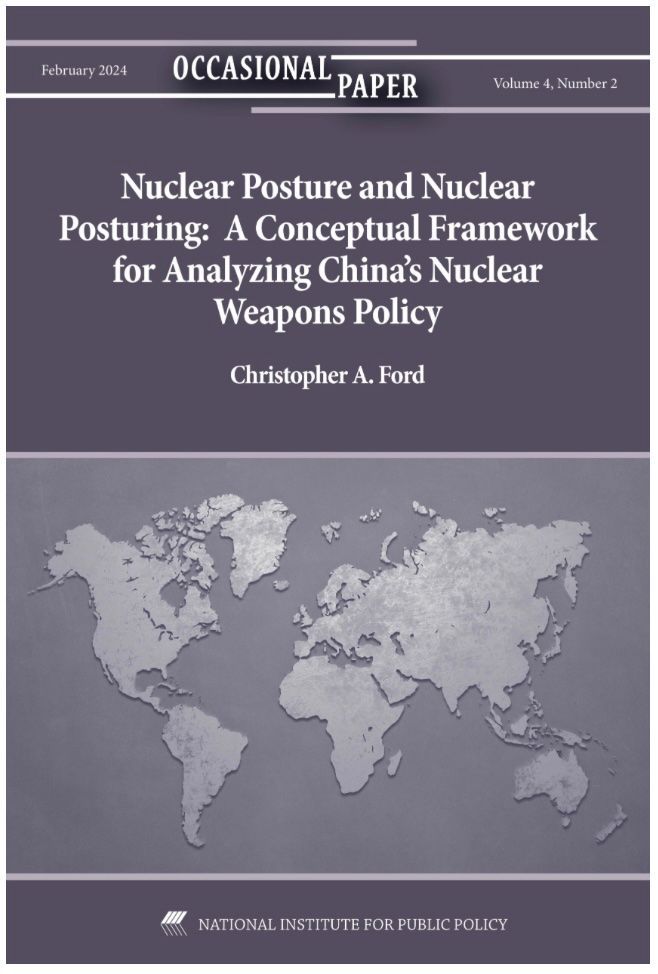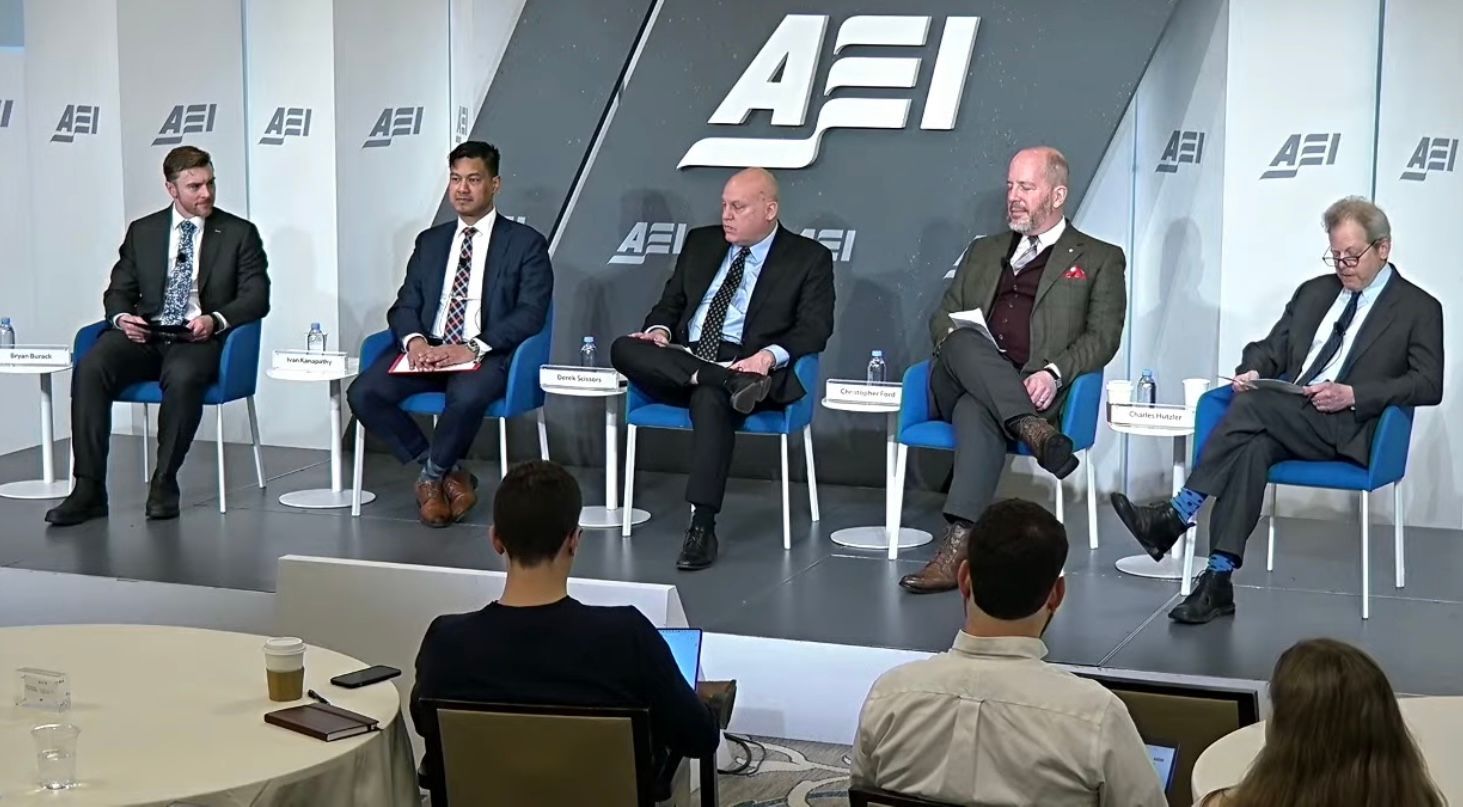The Hon. Christopher A. Ford
New Paradigms Forum -- International Security Policy Since 2009
More on “New START”: An Insider Responds, and Ford Comments
Don’t worry. In offering some assessment of the recent “New START” strategic arms deal with Russia that will soon be subject to ratification debates in the U.S. Senate, I still intend to get to issues such as missile defense linkages, telemetry, “prompt global strike” limitations, and so forth. Given my previous NPF posting on the new agreement’s “top line” numbers , however – and particularly, the treaty’s treatment of intercontinental ballistic missile (ICBM) reloads and rail-mobile delivery systems – I think NPF readers deserve more detail on the issues I raised.
I have been privately contacted by an analyst who, shall we say, has some insight into the details of “New START.” (For the sake of this discussion, let’s simply call this person Marty. For the record, that is not my contact’s real name.) In a nutshell, Marty contends that I am wrong to worry that the arcana of Protocol terminology might give reason later to conclude that the treaty entirely fails to cover rail-mobile systems. To make sure the agreement – and Marty’s points - get a fair hearing, let’s walk through the argument.
I. RAIL-MOBILE SYSTEMS
Marty thinks my initial take on Article II was correct: non-deployed launchers of any sort fall within treaty limits. Marty thinks I am wrong to worry about possible terminological implications to the contrary – articulated subsequently in my earlier posting – resulting from the Protocol’s defining rail-mobile launchers out of the definition of as “mobile launcher of ICBMs.” According to Marty, a rail-mobile or other non-self-propelled launcher without an uploaded missile would count against the 800-unit limit of Article II(1)(c). Such a launcher with an uploaded missile would count against the 700-unit limit on deployed ICBMs under Article II(1)(a). (Mobile launchers with missiles uploaded are intended to count automatically as “deployed” systems, it would appear. Warheads on them would thus count against the 1,550 deployed-warhead limit of Article II(1)(b) as well.)
It is true that the Protocol cuts rail-mobile systems out of its definition of “mobile launchers” of ICBMs. This, Marty says, was done in order to ensure that certain procedures applying to “mobile launchers” did not cover rail-mobile systems. The definitions in the Protocol are thus crafted in order to make sure rail-based systems are not “mobile launchers.” Marty did not explain what procedures it was intended to avoid applying, nor why it was good – or perhaps at least unavoidable ( e.g. , if Russia insisted upon it) – to exempt rail-mobile launchers from them. (This is something that Senators will presumably wish to pursue.) But Marty was emphatic that rail-mobile launchers, whether they are “mobile” ones or not, are still ICBM launchers , and thus fall within the 800-unit limit on deployed and non-deployed launchers. As its text suggests by not drawing any such distinction, Article II(1)(c) does not itself care whether or not a launcher is “mobile.” What matters is merely that it is a launcher.
According to Marty, the treaty is designed to cover existing types of strategic delivery system. If a new system were created, it would have to be added to the database that the treaty obliges the parties to maintain. Specifically, for instance, Marty said that if a “new type” of missile comes into existence that is either (1) launched from a silo or (2) launched from a “mobile launcher of ICBMs” as currently defined, it would have to be added to the treaty-required database. So let’s look at this.
Pursuant to Part One, ¶11(c) of the Protocol, “declared data,” which can be checked by inspections, includes information about “new types of strategic offensive arms” included in notifications. Paragraph 46 of Part One gives a definition for what it means to be a “new type” of missile, while Section II(3)(b) of Part Four requires the provision of information on the emergence of “new facilities, new types, [and] variants of ICBMs and SLBMs.” Under Sections II(4)-(5) of Part Four, notification must also be provided of the arrival at a declared facility of “the first prototype ICBM or prototype SLBM of a new type,” and notification after the 20 th launch, or in advance of deployment, of a new type.
The applicability of “new type” reporting rules to all mobile launchers still seems somewhat problematic, however, insofar as the only reference I could find to a “new type” of mobile launcher is in Section II(3)(b), which refers to “new versions of mobile launchers of ICBMs.” Since it was the choice of the treaty’s negotiators to define non-self-propelled mobile launchers out of the definition of a “mobile launcher of ICBMs,” Section II(3)(b) would not seem to require any notification of the development of new rail-mobile launchers or any other non-self-propelled launching system. (And what counts as a non-self-propelled system anyway? I have hitherto assumed that road-mobile systems fall within the category of “mobile launcher of ICBMs” set forth in Paragraph 45 of Part One of the Protocol, but what about a towed, semitrailer-style system with a detachable motorized cab? Might that slide out from under the Protocol definitions just like a rail-mounted system?)
These issues deserve scrutiny. It would be strange for Article II(1)(c) theoretically to limit the numbers of non-self-propelled launchers, but the Protocol not to require that each side report the development of new ones. Despite Marty’s reassurances, therefore, my look at the reporting requirements has so far not completely allayed my concern that the structure of the Protocol might cast doubt on the adequacy of the Article II(1)(c) limit with respect to certain mobile launchers. (Perhaps Marty will get back in touch to set me straight about something I have missed; I hope ours will be a continuing dialogue.) I would certainly like to take Article II at face value – and, on the basis of that provision itself, Marty’s textual argument seems pretty good – but the Protocol doesn’t exactly do the treaty any favors by muddying the waters in this regard. Where potential strategic breakout is at issue ( e.g. , with non-deployed MIRVed missiles ready for quick upload on non-self-propelled mobile launchers) it would surely be better for things to be a bit clearer: the non-self-propelled carve-out still seems troublesome. At the very least, I’d imagine that Senators will want these odd provisions carefully explained by the folks who negotiated them.
II. RELOADS AND UPLOADS
Marty believes my analysis was correct that missiles are not in themselves counted under “New START” limits unless and until they are loaded in or on a launcher. Thus it is apparently true that any number of reload missiles could accompany mobile launchers without counting as “deployed” missiles. By the same token, such reloads could have any number of MIRVed warheads aboard. (Warheads don’t count against the 1,550-warhead limit in Article II(1)(b) unless they are deployed, and if the missile isn’t deemed “deployed” the warheads aren’t either. The United States has announced its intention, in the Obama Administration’s Nuclear Posture Review , to de-MIRV land-based missiles. Russia has not.) The total number of ICBMs and SLBMs on each side are not counted, and as long as one doesn’t deploy them, they may apparently be possessed in unlimited quantity.
According to Marty, the U.S. didn’t want to have to destroy old missiles, since we find them useful for space launches and other such purposes. The U.S. team therefore would not have agreed to aggregate limits on non-deployed missiles. This is not to say, however, that the Obama Administration approves of Russia developing a rapid-reload capability for its growing arsenal of mobile ICBMs. In the “Fifth Agreed Statement ” – in Part Nine of the Protocol – Russia and the United States declare that “the production, testing, or deployment of systems designed for the rapid reload of ICBM launchers and SLBM launchers is unwarranted and should not be pursued by either Party.” This “agreed statement,” however, would not seem to have much, if any, bearing upon the parties’ legal obligations. (The parties may have “agreed” that this is the case, but “unwarranted” is not the same as prohibited , and “should not” is not the same as shall not. We should not mistake the “agreed statement” for a real limit: rapid-reload capabilities would seem still to be permitted.) Nevertheless, it cannot be said that the Obama negotiators simply forgot that reloads were possible. Instead, the White House simply seems not to be particularly worried about the possibility, and feels that the Fifth Agreed Statement will do enough to dissuade Russia from indulging whatever interest it might have in a rapid-reload capability, if indeed Moscow retains any such interest at all.
Two days after my NPF posting on the issue of missile reloads, the State Department offered an official response, of sorts, to the idea that “New START” did not deal adequately with this question. According to State, the “key point” was that the two parties have “agreed that the production, testing, or deployment of rapid reload systems was unwarranted and should not be pursued by either Party.” According to the Department, “[d]iscussions during the New START Treaty negotiations made clear that both the United States and the Russian Federation consider ‘rapid reload’ an unlikely scenario, and therefore agreed on this broad statement that memorializes the shared position that development of rapid reload capabilities is unwarranted.”
I am flattered that officials at the Department read this blog, but their official comment is, of course, a backhanded concession that reloading is indeed not restricted by the agreement. It’s not clear to me that all Senators will necessarily be comforted by the claim that one should not worry about reloads because that scenario is “unlikely.” Nevertheless, at least we have now identified the proper locus of Senate debate on the reload question: what danger is in fact presented by the possibility of Russia rapidly reloading its growing arsenal of mobile missiles, and is it a problem that the treaty does not formally constrain this?
While we’re at it, it might be worth having a discussion about why other previously START-constrained capabilities are also now no longer limited under “New START.” In contrast to its predecessor, for instance, this new deal does not prohibit deploying ICBMs other than in silos, or on (at least some kinds of) terrestrially-based mobile launchers. It says nothing, for instance, about non-traditional deployments such as on waterborne craft other than submarines ( e.g. , surface ships) or as air -launched ballistic missiles. (Neither of these ideas is entirely outlandish, by the way. It has been reported, for instance, that Iran tested a short-range ballistic missile from a ship in 2004 , while the old U.S. “Skybolt” concept involved launching ballistic missiles from under the wings of B-52 bombers.)
Let me stress that it is not necessarily bad that so little is actually limited by the new agreement, but it would be useful at least to acknowledge this, and to explore why. As I indicated in my earlier posting on this subject, it is not beyond argument that we have to have a traditional Cold War-style force-limit treaty with Russia at all – and indeed the Bush Administration for a time didn’t think such limits were much needed in the first place. If we are going to have such formal restrictions, however – and to invite with Moscow a rigidly-negotiated strategic relationship implying that “we condone what we do not formally constrain” – we should presumably insist that the limits are good ones, and lack worrisome loopholes. I’m looking forward to the hearings.
III. REPORTING REQUIREMENTS
A. REPORTING RULES
But let’s put the actual limits aside for the moment. To me, the most interesting aspects of Marty’s comments concerned the new treaty’s emphasis upon reporting requirements. According to Marty, the basic U.S. approach in crafting the agreement actually didn’t stress the importance of force limits very much. The aim for U.S. planners was “getting accurate reporting as to what the Russians would be doing rather than limits per se.” Despite the disarmament community’s fetishization of warhead and delivery system numbers, in other words – and, in fairness, I should note that this is now very much my own characterization, rather than Marty’s – the most important aspect of “New START” is strategic transparency.
This, Marty says, is why even though non-deployed missiles are not treaty-limited, both sides will be required to report on their possession of all strategic missiles, with each missile (including non-deployed ones) being assigned a unique identifier and given a reported location. Launchers, including mobile ones, would need to be reported too. Thus, for example, although the treaty has no formal limits on such practices, Marty anticipates that it should be possible to track whether mobile launchers are accompanied by swarms of reload missiles: the locations of all such missiles and mobile launchers would be subject to reporting requirements, and their colocation would help alert us to preparations for rapid reloading.
Being comfortable with the ability of such reporting to allay U.S. concerns over the reload issue, of course – and these probably are lopsidedly American concerns, since although we lack mobile land-based missiles, Russia has quite a few – presumes that we can trust the accuracy or timeliness of Russian-provided locational reporting on rapidly-movable assets. (Inspections, I should note, will offer at least some ability to spot-check reporting.) Nevertheless, the treaty’s approach claims to offer the possibility of having – in Marty’s words – “plenty of time to see what is happening and to decide what, if anything, to do.”
So let’s look at these reporting rules. Where do they come from? Pursuant to Article VII of the treaty, both sides are required to provide basic data as set forth in the Protocol. Under Part Four, Section II(1) of the Protocol, a set of baseline set of data must be provided within 45 days of the agreement’s entry into force. According to Section II(2) of Part Four, this data must be updated every six months, with Section II(3) also providing that “each change in data for each category of data contained in Part Two of this Protocol” not already indicated in the semi-annual updates must be provided “no later than five days after it occurs.”
Pursuant to Section I(5) of Part Two of the Protocol, “[e]ach ICBM, each SLBM, and each heavy bomber shall have a unique identifier.” As Marty indicated, this is not limited to deployed or non-deployed systems: even when not subject to treaty limits ( e.g. , in the case of non-deployed missiles) such items will nonetheless be identifiable and subjected to reporting rules.
Section II(3)(b) of Part Four says that change notifications must include such things as “[t]he emergence of new facilities, new types, variants of ICBMs and SLBMs, and new versions of mobile launchers of ICBM.” Provision is also made for notifications related to missile prototype development (§§II(4)-(6)), as well as “[n]otification concerning a new kind of strategic offensive Arm.” (§II(8)) Section II(3)(e) of Part Four also requires reporting on each “change of category of an item from deployed to non-deployed or from non-deployed to deployed.” Section II(3) notifications must be given within five days after a reportable change occurs.
Additionally, Section III of the Protocol’s Part Four addresses required reporting on the movement of strategic systems – though despite Marty’s assurances that individual ICBM locations would be reported, that section does not seem to cover ICBMs beyond the exit of solid-fueled missiles from production facilities (§III(1)) or the movement of ICBMs to or from test ranges (§III(2)). (Mobile launchers or individual ICBMs don’t seem to be covered by this provision.)
To sort out all the wrinkles of what specifically is covered in the reporting rules with regard to mobile systems, and especially non-self-propelled ones, will doubtless take more staring at the Protocol than I have yet been able to do. But the data templates provided in Part II of the Protocol clearly make some provision for locational data. Under Section II, numbers of “Deployed ICBMs” and “Deployed Mobile Launchers of ICBMs” at any particular Russian “ICBM Base for Mobile Launchers of ICBMs” must be declared on a base-by-base basis, but locational data for non-deployed missiles ( e.g. , reloads) appears not to be addressed in this context. “Storage facilities for Mobile Launches of ICBMs” are also addressed, along with “Non-deployed Mobile Launchers of ICBMs.” “Non-deployed Mobile Launchers of ICBMs” must also be accounted for at “Training Facilities,” and there is a reporting requirement for “Non-deployed ICBMs,” that appears under the heading of “Test Ranges.” Finally, under Section VII, information must be reported about assembled ICBMs or SLBMs in and out of launch canister and/or separated into stages, while Section VII(1)(a) requires reporting on Russian “Mobile Launchers of ICBMs” – including those “In Transport Position, Without Missile.”
So there clearly is at least some required locational reporting for missiles and their launchers. That said, however, such reporting requirements apply to aggregate numerical data on a facility-by-facility basis, as opposed to specific missile or launcher locational information. Article IV(3) of the treaty requires that parties locate non-deployed missiles and launchers only at designated bases and facilities, so the agreement aims to prevent their presence at other locations, and to account for all such systems in the overall facility totals. The rules are designed, in other words, to let both sides know very generally where all such systems are located, identifying them as being somewhere within the confines of specific bases, ranges, or other facilities.
But this is not the same thing as having much insight into whether quick-reload missiles – or quick-upload missiles of the sort that would instantly turn a non-deployed mobile launcher into a very threatening, albeit theoretically treaty-limited, “deployed” system – accompany mobile launchers in the field. Imagine, if you will, that I have several big missile test ranges or some other sprawling facilities: I have to tell declare these facilities to you, and tell you how many missiles and launchers I have there. I do not, however, have to reveal whether my non-deployed ICBMs there are in some long-term storage bunker (which shouldn’t bother you much) or aboard rapid-reload vehicles following launchers around in the back country (which should). Movement within the confines of a declared facility, however large, apparently need not be reported. This distinction is not irrelevant if you are concerned about my possible strategic breakout in a future crisis, and about your ability to know if any such “unlikely” thing is possible.
B. TRANSPARENCY VERSUS LIMITS: PLUS CA CHANGE ....
Quite apart from the specific mechanics of “New START” reporting requirements, however – and their adequacy from the perspective of U.S. strategic interests, which will no doubt be much debated – I am fascinated by the general emphasis upon transparency over force limits, described by Marty and clearly reflected in the elaborate reporting system of the treaty. This is apparently yet another way in which the Obama Administration has, in its somewhat muddled way, found previously-derided Bush Administration insights in fact to be profound and valuable.
As insiders will recall, during the Bush Administration’s negotiations with Russia about a successor to the expiring START agreement – the very negotiations that Obama concluded with “New START” – officials in Washington for a time thought force limits relatively unimportant. Instead, they believed strategic transparency was the key to the Russo-American nuclear relationship. In the post-Cold War environment, it was felt, each side needed a good window into how threatening the other party wasn’t. If this transparency could be had, however, the issue of actual nuclear numbers would pretty much take care of itself, precisely because we were no longer in a genuinely mutually-threatening strategic rivalry. Transparency, in other words, would help make our 21 st Century relationship of non -rivalry clear enough that both parties would feel no need to build more systems, and in fact would likely continue reducing.
The Bush Administration was eventually cajoled into agreeing to Russian demands for legally-binding force limits – a demand which, I think, stemmed more from Moscow’s desire to retain some symbolic co-equality with the global hyperpower through traditional arms control treaty relationships than from any anticipation that either either side would otherwise build up its nuclear arsenal – but it is intriguing that the Obama Administration may ultimately have adopted the fundamental Bush approach of emphasizing transparency over numerical reductions. This puts a fascinating gloss upon the remarkably unremarkable degree of the arms cuts actually mandated by “New START.” Perhaps it wasn’t ever really about cuts anyway. (Do the President’s boosters on the arms control left realize this?)
What all this means for Senate ratification, of course, is quite unclear. From a security-minded Senator’s perspective, I would imagine that the details of how transparency is handled will matter greatly. To what extent, for example, can we be assured of the kind of insights into Russian activity that we will need – and can we be assured that we will get such insights in an accurate, sufficiently detailed, and timely fashion (especially for assets that can move around freely)? Especially if transparency turns out – as Marty suggests – to be very much the point of this new treaty, are we confident that there are not loopholes in its much-vaunted reporting rules? (Remember, moreover, that there is much still to study in the treaty and its protocol, including the annexes recently finalized by U.S. and Russian officials.)
[Note: The originally-posed version of this essay remarked that these annexes are not yet available, but this is not the case. In fact, the State Department’s website includes all three of them: an inspection annex , a notifications annex , and a telemetry annex . NPF regrets any confusion the original comment may have caused.]
If it is a key rationale for “New START” that we should not worry about force limits too much because we have a good window into what Russia will be up to – and we will therefore have the ability to assess developments and react appropriately as time goes by – we should only support the treaty if we are confident that the transparency it provides is indeed good.
I am grateful to Marty for offering a critique of my earlier posting about “New START” numbers. Hopefully Marty is right that the loopholes are not as big as one might have feared. That is not the same thing, however, as saying that there are no loopholes. One imagines that this subject will be an important focus of Senate debate.
-- Christopher Ford



Copyright Dr. Christopher Ford All Rights Reserved






